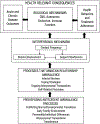Social Ambivalence and Disease (SAD): A Theoretical Model Aimed at Understanding the Health Implications of Ambivalent Relationships
- PMID: 31533019
- PMCID: PMC7089572
- DOI: 10.1177/1745691619861392
Social Ambivalence and Disease (SAD): A Theoretical Model Aimed at Understanding the Health Implications of Ambivalent Relationships
Abstract
The protective influence of social relationships on health is widely documented; however, not all relationships are positive, and negative aspects of relationships may be detrimental. Much less is known about the relationships characterized by both positivity and negativity (i.e., ambivalence). This article provides a theoretical framework for considering the influence of ambivalent relationships on physical health, including reasons why ambivalence should be considered separately from relationships characterized as primarily positive (supportive) or primarily negative (aversive). We introduce the social ambivalence and disease (SAD) model as a guide to understanding the social psychological antecedents, processes, and consequences of ambivalent relationships. We conclude by highlighting gaps in the literature and features of the SAD model that may serve as a guide to future research on potential health-relevant pathways of ambivalent relationships.
Keywords: ambivalence; health; psychophysiology; relationships; social support.
Conflict of interest statement
Declaration of Conflicting Interests
The author(s) declared that there were no conflicts of interest with respect to the authorship or the publication of this article.
Figures
References
-
- Ainsworth MDS, Blehar MC, Waters E, & Wall S (1978). Patterns of attachment: A psychological study of the strange situation. Hillsdale, NJ: Erlbaum.
-
- Andersen SM, & Chen S (2002). The relational self: An interpersonal social-cognitive theory. Psychological Review, 109, 619–645. - PubMed
-
- Andersen SM, & Przybylinski E (2012). Experiments on transference in interpersonal relations: Implications for treatment. Psychotherapy, 49, 370–383. - PubMed
-
- Aron A, Aron EN, Tudor M, & Nelson G (1991). Close relationships as including other in the self. Journal of Personality and Social Psychology, 60, 241–253.
Publication types
MeSH terms
Grants and funding
LinkOut - more resources
Full Text Sources
Medical



